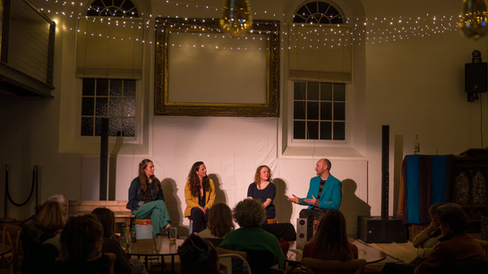Persistence will break the stone
- Charlotte Sawyer
- 5 days ago
- 3 min read
Updated: 4 days ago
Mae ein taith o amgylch Cymru wedi dod i ben. Ond cofiwch “Dyfal donc a dyr y garreg”! Hwyl am y tro!
Our tour of Wales has come to and end. But remember “Dyfal donc a dyr y garreg” which is a Welsh idiom meaning “persistence will break the stone” so we must keep going! Cheers for now!

If the stone is the overwhelming pollution destroying our previous rivers, lakes and oceans, then our persistence is love and connection.
This is me, Director Charlotte Sawyer feeling peaceful and fully alive at a secluded waterfall near Aberwystwyth on the last day of Rave On For The Avon's Welsh Tour.
Why is love and connection the key to this fight to protect our waterways? Joe Wilkins, Ecologist and Rights of Nature Campaigner based in Aberwystwyth shares why below.
Rave On For The Avon is a documentary about people who love to swim in their local river and fight to protect it in joyful ways. We are still screening in Mwldan/Cardigan until 5th May so please spread to word to people you know in the area.
A tour where the rivers joined in.
This March I travelled for Director Q&A screenings to Mwldan/Cardigan, Aberystwyth, Yr Egin/Carmarthen, Tywyn and Hay on Wye.
For some of the screening I was joined by Kim Kaos aka The Goddess of the Wye, poet Mrs Meg Avon (who marries the river in our film) and most importantly, the Avon and Wye river.

Our final screening was part of Wales' longest running film festival WOW Film festival where Rave On For The Avon won the Feature Documentary Audience Award.
In this photo is festival organiser Annita Nitsaidou Film Festival Director & Programmer on the right and in the middle Q&A host Joe Wilkins, Ecologist and Rights of Nature Campaigner based in Aberwystwyth.
Joe shares his reflections on campaigning for rivers in his part of Wales.

"Growing up in north Ceredigion, I was never far away from a river or stream. In fact, some of my most cherished childhood memories are of playing by the Afon Ystwyth, a river facing its own threats from the legacy of mining in the upper reaches and from intensive farming and industrial practices that continue to this day. So, I know first-hand the power our rivers and lakes can have on our mental and community well-being and the threats they face.

My dear friend, the Ystwyth, is not alone in facing these threats. All rivers in Wales are facing their own problems, often leading to a chemical cocktail of sewage, slurry, industrial products, pesticides, and the list goes on. Not only has water quality declined rapidly, but we have also seen the rapid loss of river habitats, which massively reduces the resilience of our rivers to cope with ever-changing pressures. Where once rivers meandered and pooled their way through hills and floodplains, now they have been forced to flow in unnatural ways as we lost our ability and desire to work with nature and instead pushed to control the planet.

In the face of all of this negative news and data, storytelling like Rave on for the Avon is so important. It doesn’t shy away from showing the issues. Of course, we’re angry and worried. Angry at polluters and politicians for not taking action. Worried about the future of these waterways and our relationship with them.
But I feel like the documentary, and the stories within, are driven by love and hope. I do believe that, at our core, we campaign and fight for this out of love and a hope for a better future.
This form of storytelling is particularly important here in Wales as rivers and water in general have defined our nation, both physically and culturally, for many years. I think we should all remember the last lines of the second verse of Mae Hen Wlad fy Nhadau (aka the National Anthem):
Trwy deimlad gwladgarol, mor swynol yw si,
Ei nentydd, afonydd, i mi.
Through love of my country, enchanting voices will be
Her streams and rivers to me.
Although perhaps not classic “rave” tunes, the fact that Welsh songs often mention rivers highlights that they are a big part of Welsh history and culture. Therefore, caring for and restoring the river is not only an environmental issue but also a social and cultural one, and we must all come together for their future. Be good future ancestors for generations to come.






















Comments